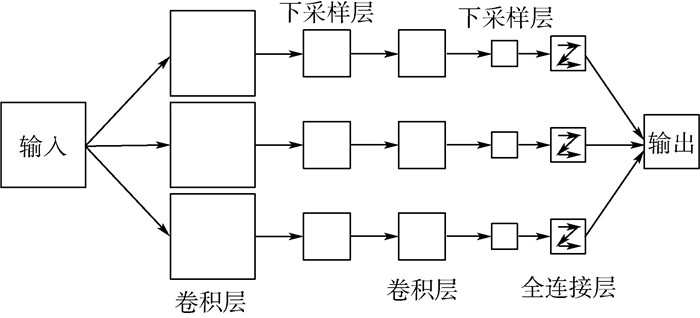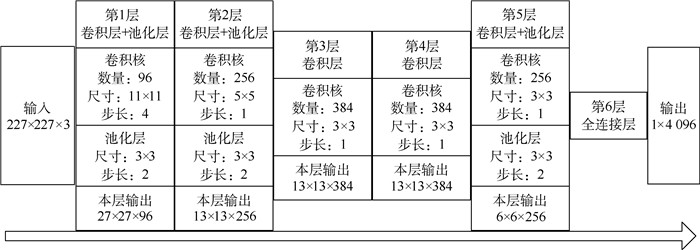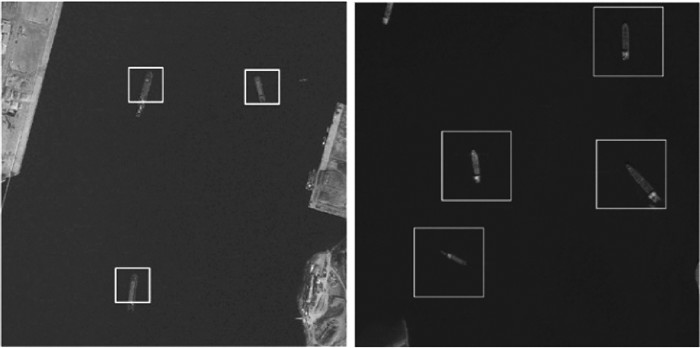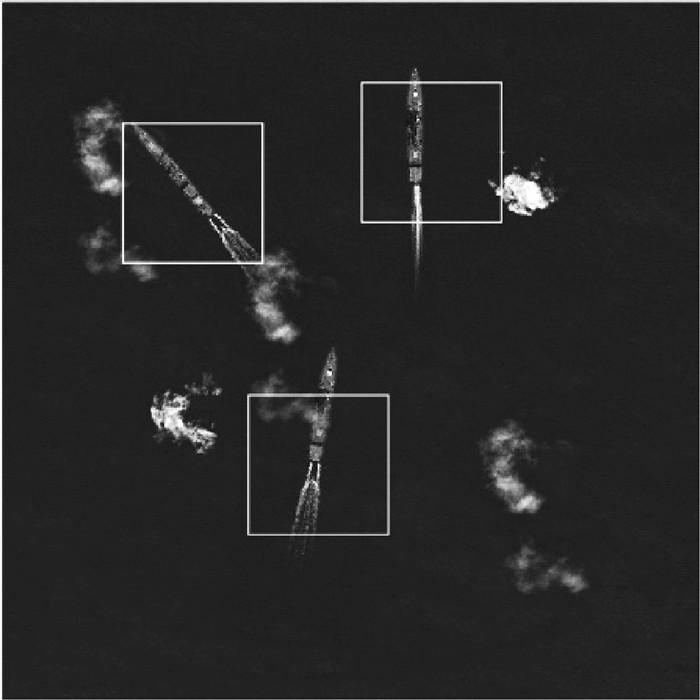-
摘要:
针对遥感图像背景复杂、受环境因素影响大的问题,提出一种将卷积神经网络(CNN)与支持向量机(SVM)相结合的舰船目标检测方法,利用卷积神经网络可自主提取图像特征并进行学习的优点,避免了复杂的特征选择和提取过程,在复杂海况背景图像的处理中体现出较优的性能;同时,由于军舰样本获取难度大,应用迁移学习的概念,利用大量民船样本辅助军舰目标的检测,取得较好的效果。通过参数调整与实验验证,此方法在自行建立的测试集上检测率达到90.59%,对光照、环境等外界因素具有一定程度的鲁棒性。
-
关键词:
- 卷积神经网络(CNN) /
- 支持向量机(SVM) /
- 舰船检测 /
- 特征提取 /
- 迁移学习
Abstract:Object detection in remote sensing images is mostly suffered from complex background and multiple interferences of environment. In this paper, a new method of ship detection is proposed, which combines convolutional neural networks (CNN) and support vector machine (SVM) to complete the ship detection task. Convolutional layers were adopted for feature extraction, taking advantages of independent feature extraction of CNNs and avoiding the process of complicated feature selection and extraction, which leads to better detection performance in complex background images. Meanwhile, since the samples of warship are difficult to acquire, samples of civil ship were employed as assistant samples for warship detection based on transfer learning theory. And this transfer learning method is proved to be effective by the experimental results, which performs better than the model trained only with warship samples. According to the parameter tuning and experimental validation, this method achieves a precision of 90.59% on testing dataset established by ourselves. In conclusion, this method possesses feasibility and robustness under different conditions of illumination and environment.
-
表 1 不同滑动窗步长测试结果(分数阈值为0.5)
Table 1. Test results on different step sizes of sliding windows (when score threshold is 0.5)
编号 步长/像素 检测框数量 位置偏移度 检测数 漏检数 虚警数 检测率/% 虚警率/% 1 100 39 0.268 8 25 27 7 48.08 13.46 2 80 44 0.220 4 32 20 9 61.54 17.31 3 60 52 0.213 9 32 20 15 61.54 28.85 4 40 71 0.195 2 45 7 23 86.54 44.23 5 20 98 0.189 6 46 6 36 88.46 69.23 表 2 SVM分类器不同分数阈值测试结果(步长为40像素)
Table 2. Test results on different score thresholds of SVM classifier (when step size is 40 pixels)
编号 分数阈值 检测框数量 位置偏移度 检测数 漏检数 虚警数 检测率/% 虚警率/% 1 0 104 0.199 7 48 5 41 92.31 78.85 2 0.5 71 0.195 2 45 7 23 86.54 44.23 3 1.0 42 0.188 7 26 26 6 50.00 11.54 4 1.5 34 0.196 1 26 26 2 50.00 3.85 5 2.0 19 0.083 7 12 40 0 23.08 0.00 表 3 不同训练集得到的军舰目标检测结果
Table 3. Warship object detection results obtained on different training sets
编号 训练集类型 检测框数量 检测率/% 虚警率/% 1 军舰 8 12.12 0.00 2 民船 44 87.88 12.12 3 民船+军舰 121 96.97 24.24 表 4 不同舰船检测方法对比实验结果
Table 4. Comparison of experimental results of different ship detection methods
编号 算法类型 检测率/% 虚警率/% 1 S-HOG[6] 50.59 25.88 2 本文方法 90.59 36.47 -
[1] 陈韬亦, 陈金勇, 赵和鹏.基于Ecogniton的光学遥感图像舰船目标检测[J].无线电工程, 2013, 43(11):11-13. doi: 10.3969/j.issn.1003-3106.2013.11.004CHEN T Y, CHEN J Y, ZHAO H P.Ecognition-based ship detection on optical remote sensing images[J].Radio Engineering, 2013, 43(11):11-13(in Chinese). doi: 10.3969/j.issn.1003-3106.2013.11.004 [2] 王彦情, 马雷, 田原.光学遥感图像舰船目标检测与识别综述[J].自动化学报, 2011, 37(9):1029-1039. http://www.cnki.com.cn/Article/CJFDTOTAL-MOTO201109002.htmWANG Y Q, MA L, TIAN Y.State-of-the-art of ship detection and recognition in optical remotely sensed imagery[J].Acta Automatica Sinica, 2011, 37(9):1029-1039(in Chinese). http://www.cnki.com.cn/Article/CJFDTOTAL-MOTO201109002.htm [3] ELDHUSET K.Automatic ship and ship wake detection in space borne SAR images from coastal regions[C]//Remote Sensing:Moving Toward the 21st Century.Piscataway, NJ:IEEE Press, 1988, 3:1529-1533. [4] ZHANG W, BIAN C, ZHAO X, et al.Ship target segmentation and detection in complex optical remote sensing image based on component tree characteristics discrimination[C]//Optoelectronic Imaging and Multimedia Technology Ⅱ.Bellingham, WA:SPIE, 2012. [5] 唐沐恩, 林挺强, 文贡坚.遥感图像中舰船检测方法综述[J].计算机应用研究, 2011, 28(1):29-36. http://www.cnki.com.cn/Article/CJFDTOTAL-JSYJ201101008.htmTANG M E, LIN T Q, WEN G J.Overview of ship detection methods in remote sensing image[J].Application Research of Computers, 2011, 28(1):29-36(in Chinese). http://www.cnki.com.cn/Article/CJFDTOTAL-JSYJ201101008.htm [6] QI S, MA J, LIN J, et al.Unsupervised ship detection based on saliency and S-HOG descriptor from optical satellite images[J].Geoscience and Remote Sensing Letters, 2015, 12(7):1451-1455. doi: 10.1109/LGRS.2015.2408355 [7] TANG J, DENG C, HUANG G, et al.Compressed-domain ship detection on spaceborne optical image using deep neural network and extreme learning machine[J].IEEE Transactions on Geoscience and Remote Sensing, 2015, 53(3):1174-1185. doi: 10.1109/TGRS.2014.2335751 [8] PROIA N, PAGE V.Characterization of a Bayesian ship detection method in optical satellite images[J].Geoscience and Remote Sensing Letters, 2010, 7(2):226-230. doi: 10.1109/LGRS.2009.2031826 [9] SHI Z, YU X, JIANG Z, et al.Ship detection in high-resolution optical imagery based on anomaly detector and local shape feature[J].IEEE Transactions on Geoscience and Remote Sensing, 2014, 52(8):4511-4523. doi: 10.1109/TGRS.2013.2282355 [10] KRIZHEVSKY A, SUTSKEVER I, HINTON G.ImageNet classification with deep convolutional neural networks[C]//Advances in Neural Information Processing Systems.Stateline:NIPS, 2012:1097-1105. [11] BOUVRIE J.Notes on convolutional neural networks[R/OL].Cambridge:Massachusetts Institute of Technology, 2006[2016-09-15]. [12] HUBEL D H, WIESEL T N.Receptive fields, binocular interaction and functional architecture in the cat's visual cortex[J].The Journal of Physiology, 1962, 160(1):106-154. doi: 10.1113/jphysiol.1962.sp006837 [13] FUKUSHIMA K.A hierarchical neural network model for associative memory[J].Biological Cybemetics, 1984, 50(2):105-113. doi: 10.1007/BF00337157 [14] GIRSHICK R, DONAHUE J, DARRELL T, et al.Rich feature hierarchies for accurate object detection and semantic segmentation[C]//Proceedings of the IEEE Conference on Computer Vision and Pattern Recognition.Piscataway, NJ:IEEE Press, 2014:580-587. [15] CORTES C, VAPNIK V.Support-vector networks[J].Machine Learning, 1995, 20(3):273-297. -








 下载:
下载:









